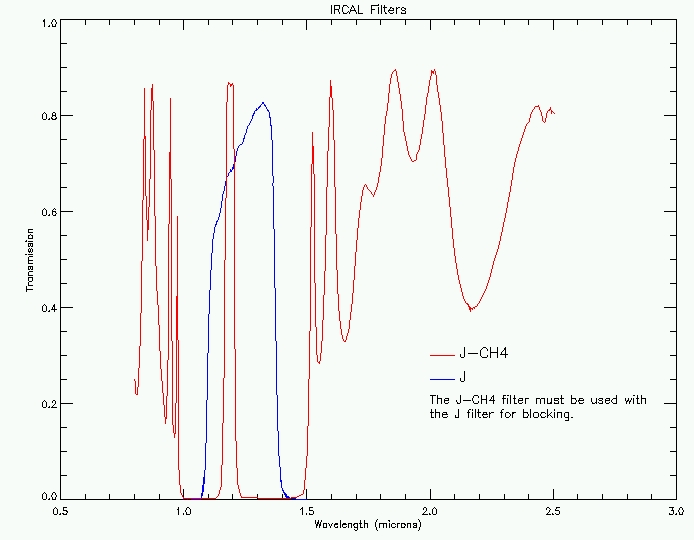Filters Grisms, Apertures, and Polarmimeter
ShARCS is equipped to do NIR direct imaging with broad and narrow-band filters, low resolution (R~700) spectroscopy in H and K-bands, and imaging polarimetry (not yet implemented, but should be soon).Filters, grisms, and apertures are selected and moved into position with the saowheels GUI, as is the Wollaston prism for the polarimeter. The polarimeter waveplate insertion and rotation has not yet been implemented, but will likely also be controlled via the saowheels GUI.
Filters
Basic specifications and characteristics for the available filters are listed below.
| Filters | |||
|---|---|---|---|
| Name |
Central Wavelength (µm) |
FWHM (µm) |
Peak Transmission (percent) |
| J | 1.238 | 0.271 | 82 |
| H | 1.656 | 0.296 | 85 |
| K | 2.195 | 0.411 | 75 |
| KS | 2.150 | 0.320 | (1) |
| H2 1-0 S(1) (H2-2.122) | 2.125 | 0.020 | 80 |
| H I (n=7-4) (BrG-2.16) | 2.167 | 0.020 | 78 |
| J CH4 (CH4-1.2) | 1.183 | 0.040 | 86 (2) |
| K CH4 (CH4-2.4) | 2.356 | 0.130 | 80 |
| 2.2/0.04 | 2.192 | 0.047 | 79 |
| H cont | 1.570 | 0.020 | (1) |
| [Fe II] | 1.644 | 0.016 | (1) |
| K cont | 2.270 | 0.020 | (1) |
Notes:
There is not space in the filter wheels for all filters. Hence, not
all filters are currently installed in ShARCS. Refer to the Summary Tables for the default installed filters. Filters not installed in ShARCS are installed in an external, warm, filter wheel.
(1)Specified, not measured.
(2)Unblocked, needs to be crossed with the J filter for blocking.
Transmission curves for some of the filters are shown below.

Click for full-sized image. |

Click for full-sized image. |
Grisms
It is possible to do moderate resolution spectroscopy with a calcium fluoride and resin replica grating grism. R=700 is chosen to fit the full bandpass of the H or K atmospheric windows in the field of view of ShARCS. When using these grism, the corresponding broadband filters (H and K) must also be inserted in the light path to act as an order blocking filter.An argon arc lamp (currently must be manually installed in the light path by a Support Astronomer) is used for calibration. Please arrange in advance of your run time to install this lamp and take calibrations during the afternoon.
(NOTE: Insert sample Argon Spectra here.)
Apertures
The aperture wheel contains an open position for direct imaging, a slit for spectroscopy, half-field aperture stop for polarimetry. Below is the full list of available apertures.
| Apertures | |||
|---|---|---|---|
| Name | Specifications | ||
| Pinhole-100um | 100 µm diameter
pinhole Used for Darks as aperture stop. | ||
| Slit-100um-V | 100 µm wide Vertical slit. Dimensions: 0.15" x 6.9". Not used. | ||
| Half-field | Half-field aperture for imaging Polarimetry | ||
| Open | Open for full field of view. Used for imaging. | ||
| Slit-100um-H | 100 µm wide Horizontal slit. Used for Spectroscopy. Dimensions: 0.15" x 6.9" | ||
| Finger | Thin wire occulting finger. 0.8" wide. | ||
Polarimeter
A Wollaston prism is installed in filter wheel #2 so it can be used with any of the filters installed in filter wheel #1 for imaging polarimetry. A half-wave plate (yet to be installed - planned to be implemented during 2015) is positioned in front of the ShARCS instrument and can be rotated to different angles for polarization detection. The Half-field aperture stop is used to prevent overlapping of the two polarization images on the detector.
Other
The other items in the filter wheels are a Pupil Viewer (for alignment checks by staff), and the Blank25 which is a piece of cold, solid metal which will block the light for Darks (usually used with the Pinhole-100um and BrG-2.16 to reduce throughput if there are any light leaks or scattered light in the system).
Last modified: Wed Jun 2 15:25:59 PDT 2021